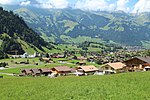Reichenbach im Kandertal

Reichenbach im Kandertal is a village and municipality in the Frutigen-Niedersimmental administrative district in the canton of Bern in Switzerland. Until 1957 it was known as Reichenbach bei Frutigen. Besides the village of Reichenbach, the municipality includes several other settlements, including Aris, Faltsche, Griesalp, Kien, Kiental, Ramslauenen, Reudlen, Scharnachtal, Schwandi and Wengi. Additionally, the village of Mülenen is shared between Reichenbach and Aeschi bei Spiez municipalities.The area played a notable role in world history when the Kienthal Conference was held at Kiental (then known as Kienthal) in 1916. The blazon of the municipal coat of arms is Argent a Bear Paw issuant from a Mount of 3 Coupeaux Vert.
Excerpt from the Wikipedia article Reichenbach im Kandertal (License: CC BY-SA 3.0, Authors, Images).Reichenbach im Kandertal
Altenweg,
Geographical coordinates (GPS) Address Nearby Places Show on map
Geographical coordinates (GPS)
| Latitude | Longitude |
|---|---|
| N 46.583333333333 ° | E 7.65 ° |
Address
Altenweg 9a
3714
Bern, Switzerland
Open on Google Maps







